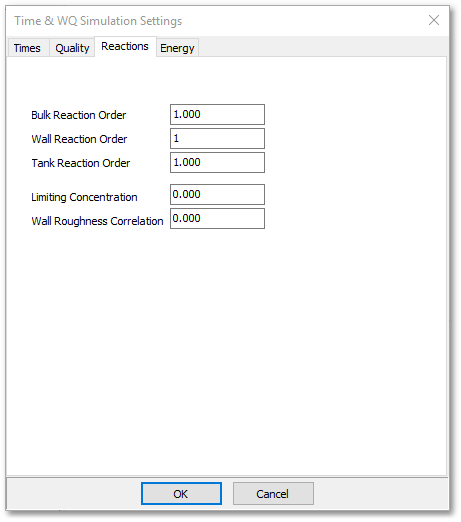The Reactions tab of the Time & WQ Simulation Settings dialog box sets the types of reactions that apply to a water quality analysis. They include the following Reactions Settings:

•Bulk Reaction Order: Power to which concentration is raised when computing a bulk flow reaction rate. Use 1 for first-order reactions, 2 for second-order reactions, etc. Use any negative number for Michaelis-Menton kinetics. If no pipe-specific bulk reaction coefficients are assigned, then this option is ignored.
•Wall Reaction Order: Power to which concentration is raised when computing a wall reaction rate. The options are FIRST (1) for first-order reactions, or ZERO (0) for constant rate reactions. If no pipe-specific wall reaction coefficients are assigned, then this option is ignored.
•Tank Reaction Order: Power to which concentration is raised when computing a bulk reactions in tanks rate. The options are FIRST (1) for first-order reactions, or ZERO (0) for constant rate reactions. If no tank-specific wall reaction coefficients are assigned, then this option is ignored.
•Global Bulk Coefficient: Default bulk reaction rate coefficient (Kb) assigned to all pipes. This global coefficient can be overridden by editing this property for specific pipes. Use a positive number for growth, a negative number for decay, or 0 if no bulk reaction occurs. Units are concentration raised to the (1-n) power, divided by days, where n is the bulk reaction order.
•Global Wall Coefficient: Default wall reaction rate coefficient (Kw) assigned to all pipes. Can be overridden by editing this property for specific pipes. Use a positive number for growth, a negative number for decay, or 0 if no wall reaction occurs. Units are ft/day (IMP) or m/day (SI) for first-order reactions, and mass/sq ft/day (IMP) or mass/sq m/day (SI) for zero-order reactions.
•Limiting Concentration: Maximum concentration that a substance can grow to, or minimum value it can decay to. Bulk reaction rates will be proportional to the difference between the current concentration and this value. See discussion of Bulk Reactions for more details. Set to zero, if not applicable.
•Wall Roughness Correlation: Factor correlating wall reaction coefficient to pipe roughness. See discussion of Wall Reactions for more details. Set to zero, if not applicable.